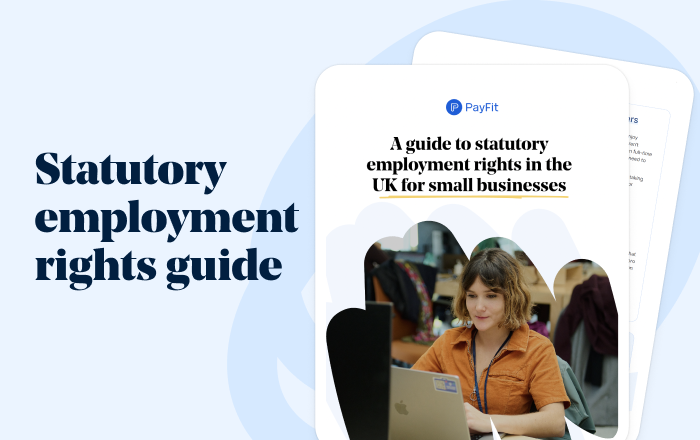✨ Health insurance, now in PayFit - learn more
💷 All the rates & thresholds you need to know for 25/26...right here
✨ The Payroll Journey: Start, Scale & Succeed Globally - learn more
✨ Health insurance, now in PayFit - learn more
💷 All the rates & thresholds you need to know for 25/26...right here
✨ The Payroll Journey: Start, Scale & Succeed Globally - learn more


Here are the essential points every employer needs to understand about notice periods:
Managing employee departures is a critical process. Whether an employee resigns or you need to end their employment, the transition must be handled correctly, especially regarding the ‘notice period’, that is, the necessary time between the announcement and when the employment effectively ends.
Getting this wrong doesn’t just lead to an administrative headache. It can lead to a breach of contract, disputes, and costly financial penalties. For HR, finance, and business leaders, understanding your obligations in this regard is therefore non-negotiable.
This article provides a comprehensive overview of the statutory notice period in the UK. We will cover the minimums set by law, how they interact with your employment contracts, and best practices for managing pay, leave, and complex situations such as redundancy.
This is a common point of confusion. The two types of notice periods are related but serve different purposes. Statutory is the legal minimum, contractual is expressly agreed upon between the two parties.
The statutory notice period is the absolute minimum notice required by UK standards, as enshrined in the Employment Rights Act 1996. It would be simple if it were a single number, but it isn’t.
The exact amount of time depends on who is giving the notice, and how long the employee has been working for the company.
When an employee resigns, the employee must give a minimum of one week’s notice if they’ve been with the company for one month’s service or more.
When an employer gives notice, the employer must give the employee:
One week’s notice if the employee has been with the company between one month and two years of service.
One week’s notice for each full year of service if they have been with you for two years of service or more.
This is capped at a maximum of 12 weeks (for 12 service years or more).
For example, an employee who has worked for your business for six and a half years of service would be entitled to six weeks’ notice from you. An employee of 15 years of service would be entitled to the maximum 12 weeks.
The contractual, agreed-upon notice period is what you agree on in your employment contract. This contractual clause can be set to suit your business needs, such as requiring a longer period for a more senior role.
However, the golden rule is that the longer period always applies. For example:
If your contract states a 30-day notice period, but the employee has eight years of service, you must give them the statutory eight weeks’ notice, as it is longer.
If your contract states a three-month notice period for a manager who has only four years of service, they are entitled to the agreed three months (which is longer than the statutory four weeks).
Failure to provide the correct notice can result in a breach of contract, opening your company up to a claim for wrongful termination.
Probationary periods often use shorter notice, such as one week’s notice from either side. This is often agreed at the start of employment, and is compliant as it meets the statutory minimum for employees with under two years of service.
If the probationary period happens to be less than a month, then the statutory minimum does not apply, as it only applies from one month’s service onwards. In this case, notice should be reasonable, but might even be a day in certain circumstances. However, it’s best to agree this in writing before the first day of work.
Fixed-term contracts automatically end on their end-date without notice. Though, if you terminate one early, the agreed or statutory notice period (whichever is longer) will apply.

UK statutory employment rights guide
Ending someone’s employment can be difficult for everyone. Following the correct procedure for the notice period is a critical part of a fair and compliant process.
For any contract termination (bar redundancy), you must provide the correct notice, have a fair reason, and follow a fair procedure. The official ACAS guidance on dismissals is an essential external resource for this.
Yes, this is summary termination. For gross misconduct (like theft, fraud, or violence at work), you can dismiss an employee instantly, without notice or pay. However, you must conduct a thorough investigation first. If you don’t have sufficient proof, you will risk an unfair termination claim.
Redundancy is a form of termination, so the same notice rules are used. The employee is entitled to their full statutory or agreed-upon notice (whichever is longer). They also legally get reasonable time off to find new work. You must also fully respect their redundancy rights, managing their final pay correctly, and including any statutory redundancy pay.
Sometimes, you may want an employee to leave immediately. In this case, you can offer Payment in Lieu of Notice (PILON), a form of Post-Employment Notice Pay (PENP). This means you pay them for their notice period, but their employment ends straight away.
Yes, and the distinction is vital for both tax and legal purposes:
Contractual provision: If your contract has a provision allowing payment in lieu, it is considered earnings, and is therefore naturally subject to Income Tax and National Insurance.
Non-contractual payment: If no provision exists, it’s technically a breach of contract, and is being offered as ‘damages’. You are compensating the employee for denying them the right to work their notice, and continue accruing benefits, such as their pension. HMRC rules, since 2018, have tightened, and today, all such payments are nonetheless treated as earnings, and are therefore taxable. However, the breach of contract creates a situation of legal uncertainty, and may lead to a claim in an employment tribunal if the employee isn’t happy with the payment you provided them with for not working.
A payment in lieu of notice must include everything the employee would have earned from the start to the end of their notice, had they been working. This requires a calculation of gross salary and may need to include contractual benefits (like pension contributions), depending on the contract’s exact wording.
You have to be sure that your payroll process correctly calculates all related tax and National Insurance. Otherwise, it could be costly if the employee thinks they have been short-changed and decides to make a claim, or if you’ve made a mistake in reporting it to HMRC.
Automated payroll software will provide crucial support here, by preventing errors in the employee’s final pay.
Garden leave is an alternative to payment in lieu of notice. The employee is paid their normal salary and receives all associated benefits, but is not, in fact, actually working. Though they still remain technically employed for their full notice period. This is often used for senior employees, so as to protect business interests, like client lists, and to enforce restrictive covenants that prevent an employee from taking certain actions leading up to and beyond their employment.
An employee’s statutory rights continue throughout their notice period, even on garden leave. They continue to accrue annual leave and other benefits. On termination, you must pay them for any untaken, accrued leave pay. Knowing how to correctly calculate statutory holiday pay is therefore essential.
Employees can also request to take annual leave during notice, subject to approval. Furthermore, an employer can require an employee to take their accrued leave, provided you give the correct counter-notice.
Managing these final pay calculations can be complex and requires a robust, reliable system to ensure accuracy.

If an employee resigns and then refuses to work their contractual notice, they are in breach of contract, as the employment contract sets out legally binding terms for both parties. As the employer, you could technically sue them for damages (e.g. the cost of hiring a temp), though this is rarely followed through. More commonly, you would simply not pay them for the time they refused to work.
Yes, absolutely. An employee on garden leave is still legally employed, and their employment contract continues in full force until their final termination date. This means all their contractual rights and benefits, including statutory and contractual holiday accrual, pension contributions, and any other benefits, remain in place. Following the correct process for managing UK garden leave, you must calculate and pay for any accrued, untaken leave as part of their final pay, just as you would for an actively working employee.
If you provide notice that is shorter than the employee’s statutory or contractual entitlement (whichever is longer), you are in breach of contract. They are, in any case, entitled to be paid for the full notice period they should have received. The employee could also make a claim to an employment tribunal for wrongful dismissal. This is a significant legal risk, and following a clear contract termination process is essential to avoid this.
Handling an employee’s exit involves complex calculations: final salary, accrued holiday pay, potential PILON payments, tax, and statutory deductions like redundancy. Modern payroll software automates these calculations, ensuring your final payslip is accurate and compliant. It provides a clear audit trail and integrates with HR software features to ensure termination dates and leave calculations are perfectly aligned, giving you peace of mind during the offboarding process.

A new flexible working law came into effect in 2024. Employees have more say over how & when they work. Understand what it means for you as an employer.

A comprehensive guide for UK employers on working time regulations, maximum hours, rest breaks, holiday pay, record-keeping, and best practices.

Explore the impact of AI in HR for businesses. Learn about tools, benefits, risks & best practices in using artificial intelligence for your HR processes.

The Alabaster ruling dictates that SMP must take into account any pay rises for the individual within a certain time period. Find out more here.

Click for an overview of UK equal wage laws, guidance on how to address equal pay issues, and where to find further advice and information.

Here, we provide a clear explanation of PENP, how it's calculated, and its tax implications, so you can tackle this tricky aspect of UK employment law.